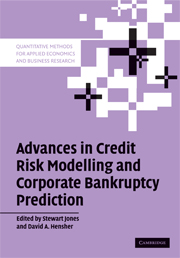Book contents
- Frontmatter
- Contents
- List of figures
- List of tables
- List of contributors
- Introduction
- 1 A statistical model for credit scoring
- 2 Mixed logit and error component models of corporate insolvency and bankruptcy risk
- 3 An evaluation of open- and closed-form distress prediction models: The nested logit and latent class models
- 4 Survival analysis and omitted dividends
- 5 Non-parametric methods for credit risk analysis: Neural networks and recursive partitioning techniques
- 6 Bankruptcy prediction and structural credit risk models
- 7 Default recovery rates and LGD in credit risk modelling and practice: An updated review of the literature and empirical evidence
- 8 Credit derivatives: Current practices and controversies
- 9 Local government distress in Australia: A latent class regression analysis
- 10 A belief-function perspective to credit risk assessments
- Index
- References
3 - An evaluation of open- and closed-form distress prediction models: The nested logit and latent class models
Published online by Cambridge University Press: 11 June 2010
- Frontmatter
- Contents
- List of figures
- List of tables
- List of contributors
- Introduction
- 1 A statistical model for credit scoring
- 2 Mixed logit and error component models of corporate insolvency and bankruptcy risk
- 3 An evaluation of open- and closed-form distress prediction models: The nested logit and latent class models
- 4 Survival analysis and omitted dividends
- 5 Non-parametric methods for credit risk analysis: Neural networks and recursive partitioning techniques
- 6 Bankruptcy prediction and structural credit risk models
- 7 Default recovery rates and LGD in credit risk modelling and practice: An updated review of the literature and empirical evidence
- 8 Credit derivatives: Current practices and controversies
- 9 Local government distress in Australia: A latent class regression analysis
- 10 A belief-function perspective to credit risk assessments
- Index
- References
Summary
Introduction
As was seen in Chapter 2, the discrete choice literature has witnessed tremendous advances over the past decade. A range of sophisticated choice models have been developed and applied throughout the social sciences. Only very recently has this literature been applied to accounting and finance-related research (see Jones and Hensher 2004). Essentially, the discrete-choice literature has developed down two distinct paths: one is towards open-form (simulation based) choice models, the most prominent of which is the mixed logit model and extensions such as the error component logit model. The other approach has developed down the path of closed-form models (also called generalized extreme value or GEV models), the most prevalent of which are the multinomial nested logit and latent class MNL models. Both open- and closed-form models have a number of unique advantages as well as some limitations associated with their use, hence the issue of their comparative performance is an important empirical question in evaluating the full potential of these models in accounting research. In this chapter, we compare the explanatory and predictive performance of the open-form mixed logit model with two sophisticated and widely used closed-form models, multinomial nested logit and latent class MNL (see Train 2003).
Chapter 2 provided an illustration of the performance of the open-form mixed logit model (with error components) in the context of financial distress prediction.
Information
- Type
- Chapter
- Information
- Publisher: Cambridge University PressPrint publication year: 2008
